Leucostoma persoonii and Leucostoma cincta
Gummosis refers to the oozing of sap or gum from a tree. This behavior is very common on stone fruits, including apricots, peaches, and plums.
You can look at gummosis as your tree’s cry for help in the face of any one of a number of problems.
The most common cause of gummosis is a fungus originally called Cytospora that is now called Leucostoma.
This fungus is opportunistic. That means that it infects easy targets like weakened trees. It requires both a wound and a tree that is stressed.
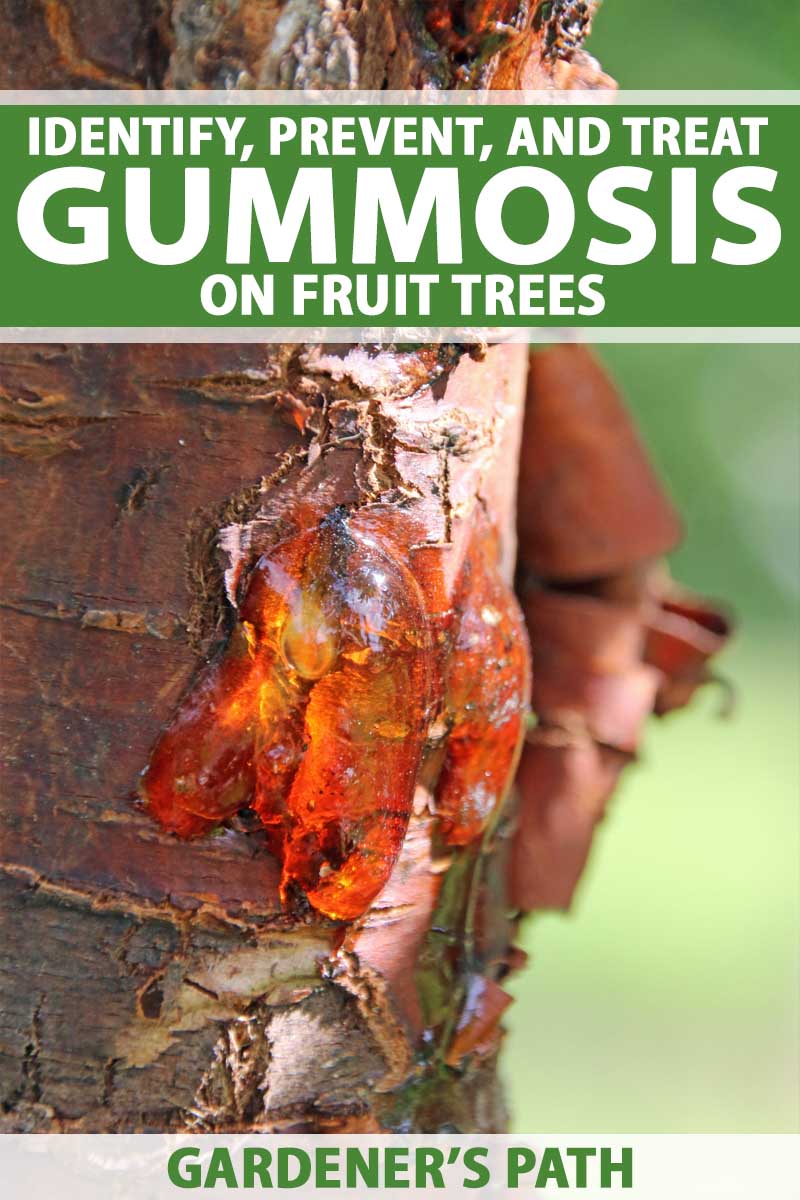
We link to vendors to help you find relevant products. If you buy from one of our links, we may earn a commission.
Pruning cuts are a major source of entry for this fungus. Sunscald and cold injury – and even deer rubs – can make your tree vulnerable to Cytospora infection.
Prevention is the best way to manage this condition.
What You Will Learn
Two Leucostoma Species Infect Fruit Trees
Two species of Leucostoma can be on the attack. L. persoonii is more likely to infect apricots, plums, peaches, nectarines and cherries grown at a low elevation. This species is more of a problem in warmer climates.
In contrast, L. cincta is more likely to attack apples and cherries in cooler areas, like orchards at high elevations.
Both species of fungus are widespread in the US and throughout British Columbia and Ontario, Canada as well. They have also been known to cause problems in South America, Europe, and Japan.
How to Diagnose Gummosis Due to Leucostoma Canker
Your tree will exhibit symptoms like dieback of the canopy and tree flagging. And it will produce a lot of gum. Think excessive.
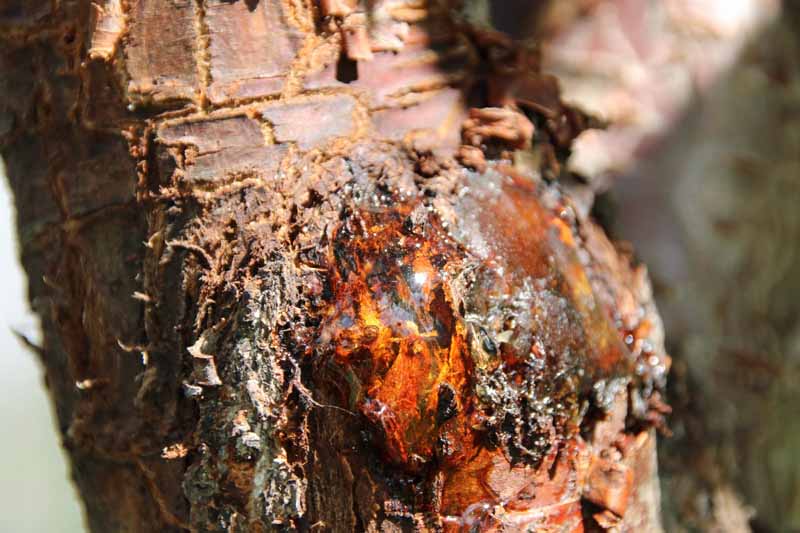
The gum that Leucostoma fungi produce has a dark amber color. Scrape off the bark and look at the phloem underneath. It will be cinnamon brown.
Typically, the fungus grows during favorable times like the winter and spring. When the tree starts actively growing, it walls off the infection until it loses resistance again in the fall. You can see this pattern in the form of bands of lighter and darker colored tissue.
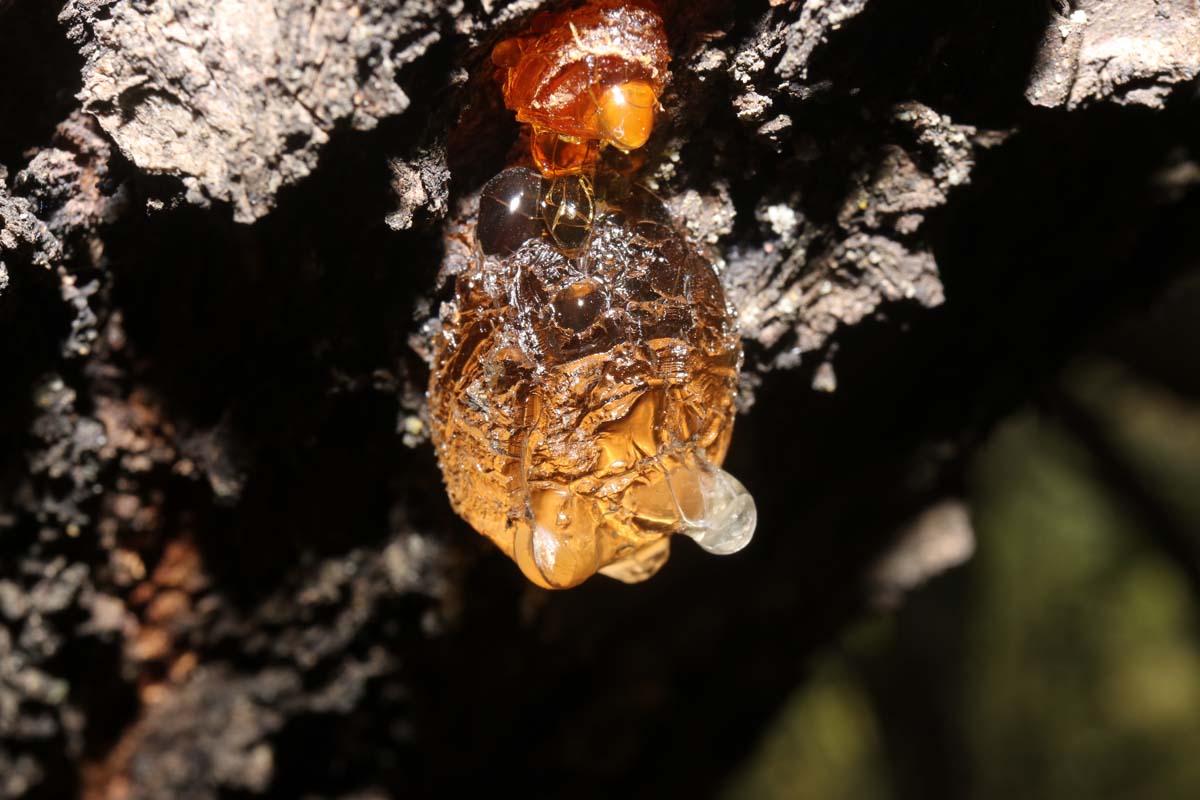
To distinguish Leucostoma canker from other causes of gummosis, you should look for its fruiting bodies – protrusions from the surface of the woody tissue that look like small black pimples.
These fruiting bodies can produce thousands of spores, and those of L. persoonii can travel up to 260 feet.
How to Prevent Gummosis
Cultural Controls
1. Optimal Fertilization and Care
Since the primary causal agent of apricot, peach, and plum gummosis attacks weakened trees, do your best to keep yours healthy with optimal mulching, watering, and nutrition.
You should consider fertilizing with nitrogen in the late winter or early spring. This will prevent your tree from producing growth that could be damaged by cold in the fall.
2. Prune Precisely and Remove Damaged Tissue
Be very careful when you prune. Make proper cuts and do not prune in wet weather. It is important to not leave stubs or flat cuts and to not make flush cuts.
Remove infected limbs and twigs by carefully pruning back to the healthy wood. You should do this during dry weather in the summer if possible, so the wound will heal as quickly as possible.
Sterilize your tools with Lysol wipes or 10% bleach between cuts.
It may not be possible to prune out all of the damage if the fungus has spread.
3. Protect from Sunscald
Protect the bark of your tree from sunscald during the winter. To do this, you have two choices.
One is to paint the trunk with half white latex paint and half water.
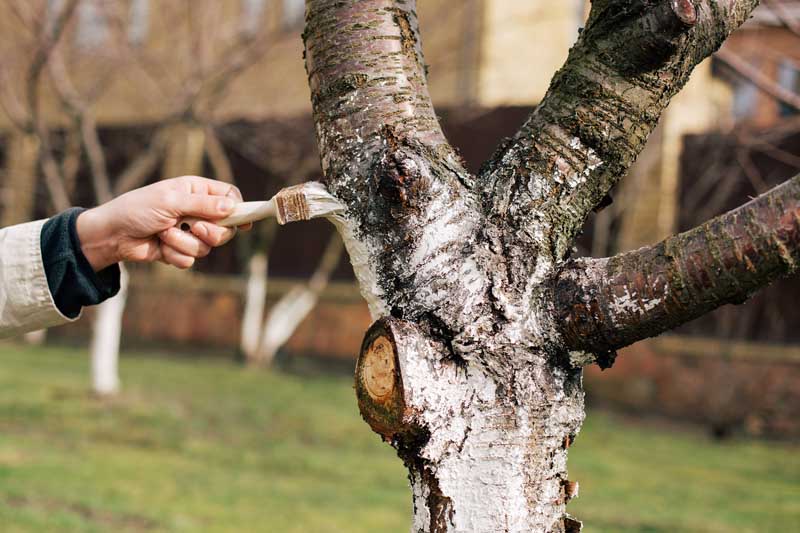
Your other choice is to apply white tree wrap from December to March.
4. Protect Against Rodents and Insects
Treat for rodents and insects, so they won’t create wounds in your tree. Some growers spray insecticides to keep borers from generating holes in the trees.
5. Drain Water from the Base of the Tree
You want to be sure to prevent injury to the crown from the cold. You can do this by draining water away from the tree’s base.
Chemical Controls
If you live in area where this pathogen is widespread, you should treat your tree with chemicals as a preventative measure.
Apply captan, thiophanate-methyl, or lime sulfur (Bordeaux mixture) in 50% latex or kaolin clay to freshly cut pruning wounds. Do not apply copper hydroxide, since this has been shown to be toxic to the trees.
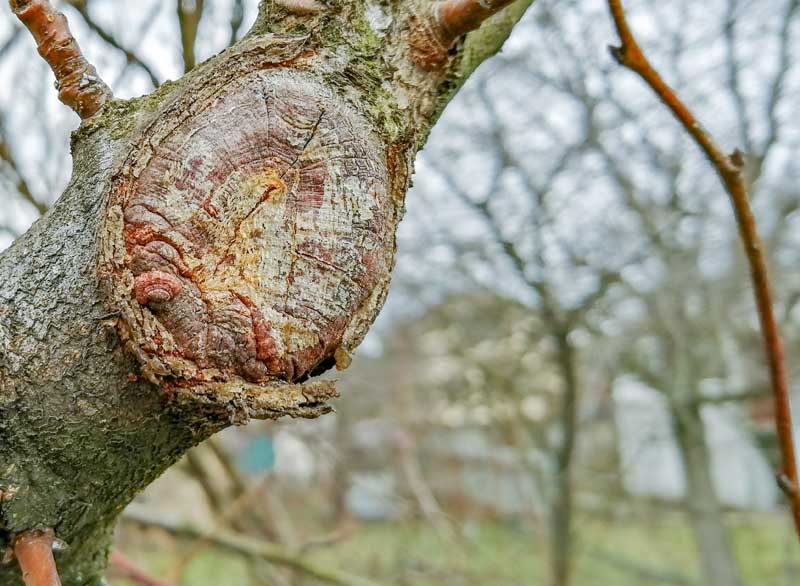
If your trees are part of an organic program, lime sulfur is safe to use.
Monitor Your Tree Closely
Try and make sure that your tree is not stressed and doesn’t have any wounds on it.
Leucostoma canker is common in backyard trees, so be very careful when you prune them. You may want to apply a chemical treatment after pruning, so the fungus will not be able to enter through pruning wounds.
Keep an eye out for gummosis. If you see it, try and determine if it is due to fungal injury. If so, quickly prune out the damaged tissue before it spreads.
And if you do lose a tree to this fungus, please remove it. The fungus will continue to live on the dead tissue and will keep producing spores to infect other trees.
Have you waged war against gummosis in your garden or home orchard? If so, let us know how it went in the comments.
And for more information on growing fruit trees, check out some of our other guides:
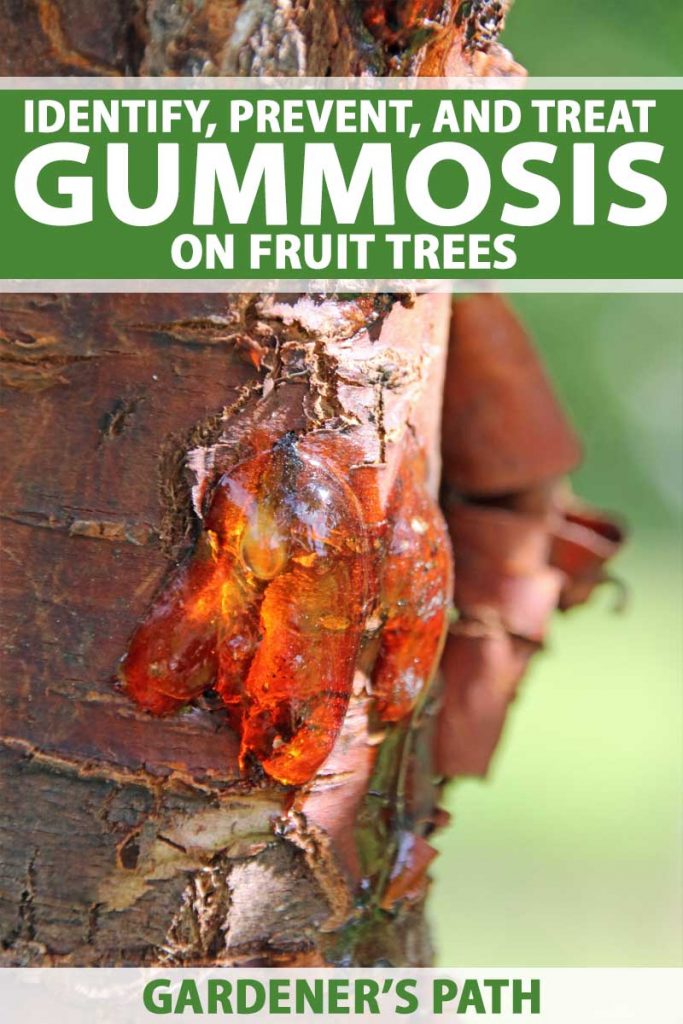
I was told my orange tree has this and to use Monterey garden phos., and he said “foot rot” also. Lost instructions- do I spray on root areas also?
Dear Doris,
Thank you so much for your question! I’m so sorry that your tree has gummosis. Yes – you should also spray the root areas. I hope your tree gets better!
I think my tree has gummosis. What should I do?
Hi Michelle, I’m sorry that your tree has gummosis. There may not be a lot that you can do after the fact. A key thing to do is to figure out whether your gummosis is due to a fungus or not. Look for protrusions on the wood that look like black pimples. If you see those, the gummosis is due to a fungal infection. Prune out the infected areas as soon as you can to prevent further spread. You should clean your pruning tools between cuts, so you don’t spread the infection. You can use either rubbing alcohol or bleach.
I have a fruit tree that has a huge opening in the trunk that I believe has gummosis. Once it is in the trunk, should the tree be removed or can it be treated?
There are a lot of causes for gummosis, so your first step is to determine whether it is due to a fungal infection or not. Look closely at the wood in the opening, and see if there are small protrusions that look like black pimples. If so, prune out the damaged area. Unfortunately, fungicides will not work at this point. You don’t need to remove the tree unless it dies. Hopefully it won’t come to that, but it will keep spreading the infection even after death.
Well, if you have other trees right around it, why won’t it infect the other trees? Wouldn’t it have to be removed? To protect the other trees?
These pictures are in reference to the photos below, and wondered if I have to take the tree out to protect the other trees. .
Hi. I have a mango tree and not sure if it has gummosis. The leaves also have brown around them. Please look at the pictures and give me any suggestions… thanks
Hi Jessica, I’m sorry that your mango tree is showing such symptoms. Gummosis is a general term for conditions that cause those types of systems on the trunks, so I would say that your tree has gummosis. The fissure in the trunk looks like your tree has bacterial canker (Xanthomonas campestris). Are the cankers gummy? If so, spraying the whole tree with copper every 10 days should help. However, the symptoms on the leaves would not be caused by that disease. It looks like it could be a response to a heavy application of fertilizer. Have you fertilized your tree… Read more »
Hi, my peaches are all oozing a clear hard substance. The rest of the tree looks great. Any ideas?
Hi Rick, The most likely possibility is that an insect like a stink bug has pierced the flesh of the fruit. If that is the case, you will have to cut the blemish out of the fruit before you can eat it. A less likely possibility is that the fruit are sunburned. There isn’t much you can do in that case.
That looks like damage due to the oriental fruit moth to me
Hi Kathy, Thank you so much for sharing that information with us! I will do some research on the oriental fruit moth.
My peaches look similar – splitting with a clear substance oozing from them. A local nursery said definitely gumosis. And now that the leaves have fallen I see a some amber colored jelly like substance in a couple of places on branches.
FWIW I should add that I live in a high desert environment and it can get windy here in northern Nevada…
Hi Paul, I’m sorry to hear that. It’s good that you got a diagnosis, but many things can cause gummosis: diseases, insect infestations, environmental stress, mechanical injury, herbicide damage, winter damage. If your fruit are affected, too, I think that would rule out mechanical injury. I’m wondering if you might have a borer infestation. There are several types that affect peach trees. I wonder about winter damage, too. It is probably cold now in northern Nevada. Here is an article about different types of fruit tree borers that describes which symptoms to look for (in addition to gummosis). It would… Read more »
I don’t doubt the stink bugs but it’s also caused by a white Chinese moth. My poor beautiful peach tree is now dying from gummosis! I’m afraid it will has to be cut down. Probably got it from when it was pruned last fall. Maybe from the pruning equipment or got in there in the wounds. Those moths are crazy killers, can’t get rid of them.
Hi Ashley, I’m so sorry to hear that your peach tree is dying! Gummosis is a cry for help for many different problems. I just mentioned stink bugs, because they are so common. Do you have any photos of the horrible moths?
My peaches have this coming out of them. What can I do to prevent this from happening next year?
Hi Stephanie, Do you mean your peach fruit, or the tree? It’s hard to advise you without knowing exactly what is causing the gummosis. It’s your tree’s cry for help, so it could be due to any one of a number of factors. If you have sunken dark tissue on the stems, it is probably the fungus Leucostoma, which the article discusses. However, it can also be due to mechanical damage (hitting it with a mower or weed whacker), herbicide damage, insect infestations, certain viruses, winter damage, or environmental stress. Is there sawdust in the gum? That would suggest a… Read more »
I have similar issue. Did you find any solution? Thanks
Hi Anu,
I’m sorry that your tree also has such symptoms!
As I described above, it looks like a severe insect infestation – probably twig borer or Oriental leaf moth.
I advised bringing in an arborist or contacting your county USDA person to help diagnose exactly what is going on and help you to treat it.
Please let us know what you find out.
After researching on the web, I believe my mango tree has gummosis. Any advice that you can give to help me bring this tree back to a healthy state would be much appreciated.
Hi Gabriel, Unfortunately, you are correct. Gummosis can indicate any one of a number of problems, but in your mango’s case, I think it is due to bacterial canker (caused by Xanthomonas campestris). You should prune out any infected twigs, although I don’t know how feasible that is. Also spray with copper when the weather is wet to help keep the infection from spreading.
THANK YOU!!!
Please advise on “spray with copper,” not sure what you mean by that.
Also, I read that I should sterilize a sharp knife and cut 1 inch around cracks and peel off the bark to allow the healthy wood trunk to heal itself.
Is there a spray to hook up to a hose, like from Home Depot, that would help with the first picture, what looks like fungus on the leaves and fruit branch portions?
Thanks again…
Hi Gabriel, That makes sense to cut around the cracks and peel off the bark. Sorry I was not more clear about the copper. Many companies make sprayable forms of copper to treat bacterial and fungal diseases. Here is a similar product that you can hook up to your hose to spray. It sounds like you are on the right track to cure your tree, and I hope that you are able to do so.
Do you think my peach tree has gummosis? What can I do?
Hi Neha, It’s difficult to tell from the pictures, but I believe that you are right. Gummosis can be caused by many factors, so what you should do depends on what is causing the disorder. One common reason is a fungus that infects through pruning wounds. Look closely at the bark and see if there are structures that look like small black pimples. If there are, that means your tree is infected. You should carefully prune out the damaged tissue to the healthy wood and make sure to sterilize your pruning shears as you go. You can use bleach, or… Read more »
Around 30% of my peach tree leaves started curling with bulges, some yellow leaves, and of course sap leaking from the stems. I’m more than positive this is Gummosis from fungi but in your expert opinion do you think the curling is a byproduct from the Gummosis since it’s also fungi based or is it two different types of fungi causing both Gummosis AND peach tree curling? Is it also too late for any meaningful preventive measures? Just today I have started pruning but I have little hope it’ll prove effective.
Hi Abe, I’m so sorry to hear that your peach tree is exhibiting symptoms. Do the curled leaves turn crazy colors? There is a very common disease called peach curl that doesn’t cause the tree to leak sap. I am wondering if you might have a different disease than the leaf curl one caused by Taphrina. If you do have the peach leaf curl disease and leaking sap, I would say that you have two separate problems. I would suggest that you get a professional diagnosis to figure out exactly what is going on. Do you have an agricultural university… Read more »
Is this gummosis? i just recently noticed this on my lemon tree and some branches have died already and I had to cut them off. I was planning to spray Dithane contact fungicide and was wondering if it could cure them, but afraid to spray directly on fruits as it might affect them too. thanks!
Hi Gaia, Yes. It looks like gummosis. However, a number of factors can cause that, including fungi, insects, and even physiological disorders. I would hold off on applying the fungicide for now until you can get a diagnosis for the problem. Even if it is due to a fungus, not every fungicide works on every fungal pathogen. One candidate is root rot caused by Phytophthora. This water mold rots the root system, so the rest of the tree suffers. Carefully dig near the crown of the plant and see if the fine roots are rotten or healthy and white inside.… Read more »
Hi,
Last year I planted bare root North Star cherry. This spring it started leaking sap in five sap mounds on the trunk, starting about four feet above the ground .The sap oozing from cherry tree is free of sawdust.
Is it harmful for the tree? What to do? Thank you in advance, Milla
Hi Milla, I am so sorry that your cherry trees are exuding so much sap! It’s good that it is free of sawdust, but it could still indicate a problem. So many factors can cause gummosis that I can’t diagnose it very effectively. It is a huge help that you provided pictures. The plants look so healthy otherwise! If you look at the stem, are there any sunken parts under the gum? That could indicate a fungal infection. Since I can’t say for sure, I would suggest that you bring in an arborist, or someone else who is specialized at… Read more »